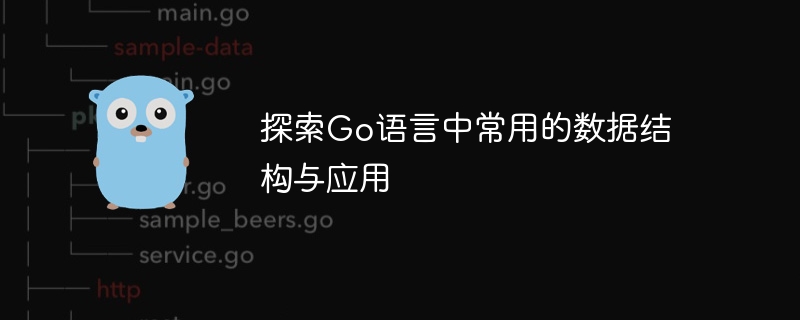Home >Backend Development >Golang >Research on commonly used data structures and applications in Go language
Research on commonly used data structures and applications in Go language
- WBOYWBOYWBOYWBOYWBOYWBOYWBOYWBOYWBOYWBOYWBOYWBOYWBOriginal
- 2024-01-10 18:15:421327browse

Explore commonly used data structures and applications in Go language
Overview
Go language is a powerful programming language with simple, efficient and concurrent programming features Features. In Go's standard library, there are many commonly used data structures and algorithms, which provide developers with rich solutions. This article will focus on commonly used data structures in the Go language and provide corresponding code examples.
- Array (Array)
Array in Go language is a fixed-length sequence of the same data type. The size of the array is determined when it is created and cannot be changed. The following is a sample code for declaring and initializing an array:
var arr [3]int // 创建一个长度为3的int类型数组 arr[0] = 1 // 第一个元素赋值为1 arr[1] = 2 // 第二个元素赋值为2 arr[2] = 3 // 第三个元素赋值为3
- Slice
A slice is a dynamic array in the Go language that can automatically expand and contract as needed. Unlike arrays, the length of a slice can change at any time. The following is a sample code for declaring and initializing a slice:
var slice []int // 创建一个空的int类型切片 slice = append(slice, 1) // 向切片添加一个元素 slice = append(slice, 2, 3, 4) // 向切片添加多个元素
- Map (Map)
A map is an associative array in the Go language that associates keys and values. The keys in the map are unique and each key corresponds to a value. The following is a sample code for declaring and initializing a mapping:
var m map[string]int // 创建一个空的string类型到int类型的映射 m = make(map[string]int) // 初始化映射 m["one"] = 1 // 添加一个键值对 m["two"] = 2 // 添加另一个键值对
- Linked List
Linked list is a common data structure that consists of a series of nodes, each A node contains a data element and a pointer to the next node. The following is a sample code for declaring and using a linked list:
type Node struct {
data int
next *Node
}
func main() {
var head *Node // 头节点
var tail *Node // 尾节点
head = &Node{data: 1} // 创建第一个节点
tail = head // 将尾节点指向头节点
tail.next = &Node{data: 2} // 创建第二个节点
tail = tail.next // 将尾节点指向第二个节点
fmt.Println(head.data, head.next.data) // 输出第一个节点和第二个节点的数据
}- Stack (Stack)
The stack is a first-in, first-out (Last In, First Out) data structure. Insert and delete operations are only allowed at one end of the table. The following is a sample code that uses slices to implement a stack:
type Stack []int
func (s *Stack) Push(data int) {
*s = append(*s, data)
}
func (s *Stack) Pop() int {
if len(*s) == 0 {
return 0
}
data := (*s)[len(*s)-1]
*s = (*s)[:len(*s)-1]
return data
}
func main() {
var stack Stack
stack.Push(1)
stack.Push(2)
stack.Push(3)
fmt.Println(stack.Pop())
}- Queue (Queue)
Queue is a first-in, first-out (First In, First Out) data structure. Allows insertion operations at one end of the table and deletion operations at the other end of the table. The following is a sample code that uses slices to implement a queue:
type Queue []int
func (q *Queue) Enqueue(data int) {
*q = append(*q, data)
}
func (q *Queue) Dequeue() int {
if len(*q) == 0 {
return 0
}
data := (*q)[0]
*q = (*q)[1:]
return data
}
func main() {
var queue Queue
queue.Enqueue(1)
queue.Enqueue(2)
queue.Enqueue(3)
fmt.Println(queue.Dequeue())
}Summary
This article introduces commonly used data structures in the Go language and provides corresponding code examples. Although the standard library of the Go language has provided many excellent data structures, in actual applications, we may also need customized data structures based on specific needs. By mastering these common data structures, developers can solve problems more efficiently and improve code readability and maintainability.
The above is the detailed content of Research on commonly used data structures and applications in Go language. For more information, please follow other related articles on the PHP Chinese website!

